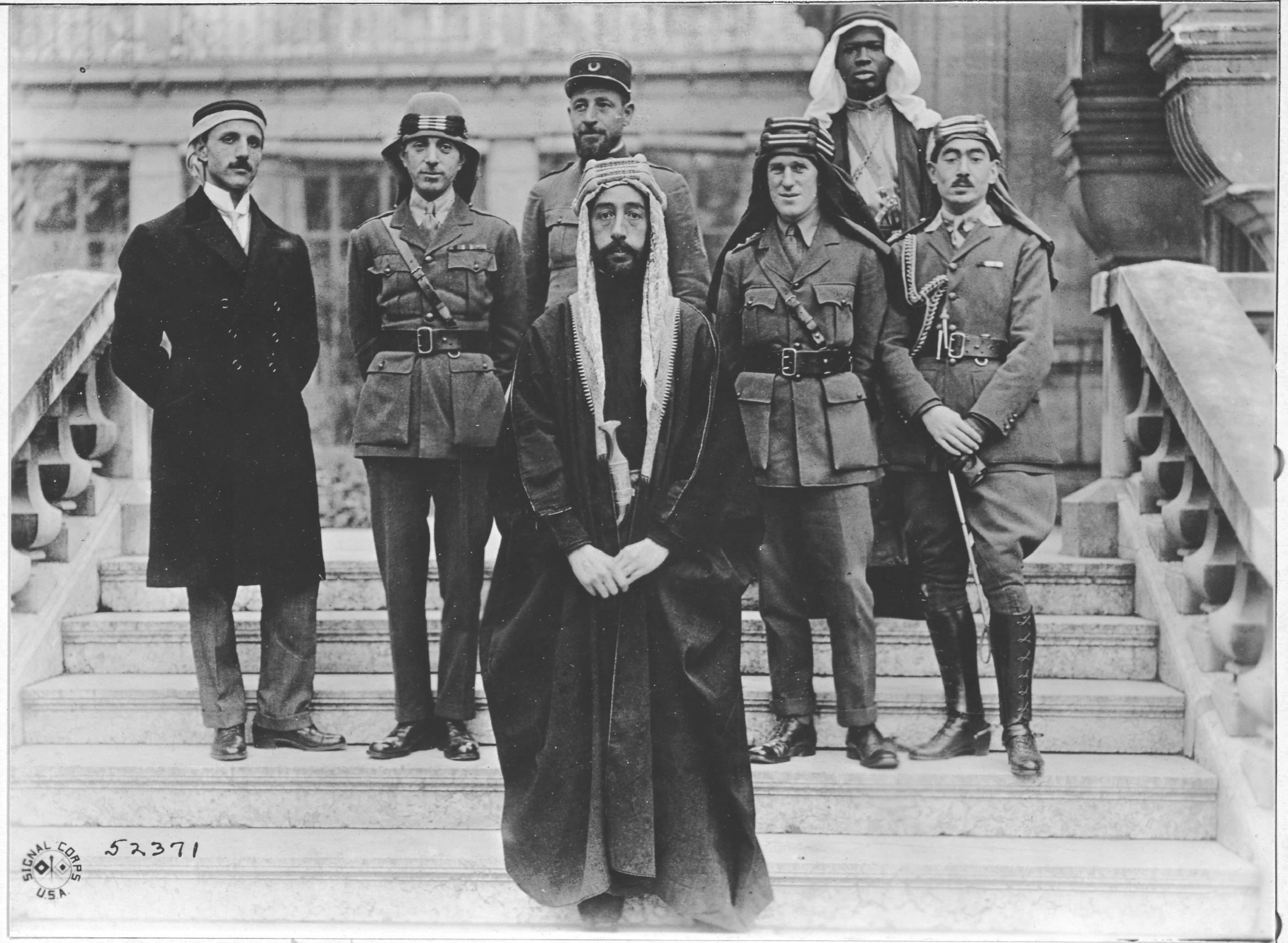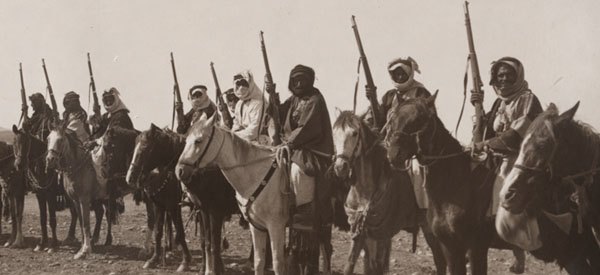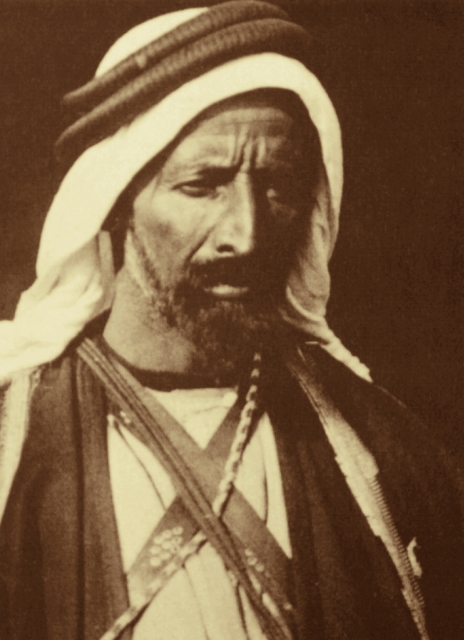Apart from it’s mountainous view, the concrete blockhouse atop Abu el Lasan was an otherwise forgotten roadmark within the Arabian desert on July 2nd, 1917. Situated between the small town of Ma’an and the port of Aqaba on the Red Sea, the blockhouse was home to a Turkish battalion, recently arrived to drive out the handful of Arab rebels. The size of the Turkish force was likely unnecessary given that the few Arabs scattered with the battalion’s arrival, but since the rise of the so-called “Arab Revolt” the previous summer, more and more Turkish regulars had been dispatched to try and re-occupy the lands of the Hejaz.
As the Turkish battalion made camp, the surrounding hills of Abu el Lasan revealed their own occupants – hundreds of rebels from the northern Howeitat tribe of Bedouin Arabs. Led into battle by their Sheikh, Auda ibu Tayi, the tribesmen overwhelmed the Turks, slaughtering 300 of their number – the majority while trying to surrender. For the loss of only 2 men and a handful of wounded, the path to Aqaba had been cleared. Four days later, as British warships pounded the port city and Ibu Tayi’s men marched against scant Ottoman resistance, Aqaba fell. The last Turkish port on the Red Sea was in the hands of the Entente – and had been delivered by Arab forces acting largely independently of their British allies.
News of the operation would capture the attention of the world due to the promotional skills of it’s brainchild – British Military Intelligence officer and adviser to the Hashemite Army of the Arab Revolt, T.E. Lawrence. Lawrence had almost not survived the battle at Abu el Lasan. While Auda ibu Tayi suffered several gazing shots, Lawrence found himself thrown from his camel at the beginning of the fight. His Arab compatriots rushed to his side to find Lawrence unharmed but his poor animal with a gaping bullet wound to the head. For despite the dashing persona Lawrence would soon encourage among the world’s press, Lawrence was actually quite poor at riding or fighting – he had accidentally shot his camel in the back of the head.

Lawrence his men pose for a photograph after Aqaba – Lawrence was always very conscious of his media image, and that of the Arab Revolt
By the summer of 1917, what had been missing in the Arab Revolt were Arabs. There were no shortage of military advisers under the banner of Sharif Hussein bin Ali. French Muslim officers and former Ottoman commanders populated the ranks of the conventional Sharifian Army and the tribesmen-based Hashemite Army under the control of Hussein’s sons Abdullah and Faisal. But their combined forces reached fewer than 30,000 men at their apex, many of whom were former Ottoman soldiers from across the Turkish empire who had deserted while stationed in the desert. Despite the £220,000 a month the British were pouring into the rebellion (the equivalent of £11,470,000/month now), the Arab Revolt had failed to attract many supporters or win many victories.
The British had managed to assist an advance along the coast of the Red Sea as the Royal Navy shelled Ottoman ports until they were abandoned and claimed by Hashemite forces. At the port of Wejh in early 1917, the British supported Faisal’s estimated 10,000-man army by landing their own marines, and a contingent of Faisal’s troops, to the north, outflanking the 800-man Ottoman garrison. Wejh surrendered with little of a fight.
When the Arab Revolt marched without British support, they failed and failed badly. Faisal had twice learned that lesson the hard way in the fall and winter of 1916 as his offensive against Medina was easily repulsed by the Turks and the British were required to come to the Revolt’s aide when Ottoman forces threatened to reclaim the key Arab supply port of Yanbu.

Prince Faisal (center) – T.E. Lawrence is over his shoulder to the right
The siege of Yanbu ended Faisal and Abdullah’s dream of a large, conventional Arab army that could not only conquer Ottoman territory but serve as a potential check against post-war Entente ambitions. Unlike the progression of events as depicted in director David Lean’s famous Lawrence of Arabia nearly 50 years later, Britain and France actually wanted their Arab allies to conduct a guerrilla campaign in the Hejaz rather than casting their lot with the conventional Sharifian Army. While Faisal and Abdullah bemoaned their lack of operational control, the early months of 1917 saw British officers like Major Herbert Garland and former Ottomans like Aziz ‘Ali al-Misri leading Arab raiding parties deep into the desert, reeking the sort of havoc on the Turkish railways that would historically be associated with Lawrence and Faisal.
The primarily British-led campaign against the railways of the Hejaz effectively severed Arabia from the Ottoman Empire as tracks could be destroyed far faster than the Turks could possibly hope to repair them. Often the various bridges and railways were “scientifically shattered” – damaged beyond repair but left largely intact. Ottoman crews would have to demolish entire otherwise healthy sections of rail just to get the tracks functional again.
Such immediate successes made an Ottoman counteroffensive inevitable. A March counterattack with Arab allies from the Ha’il region left the Hashemite tribesmen repulsed back to their British-backed port cities and the rebellion looking as weak as ever. With British troops deadlocked at Gaza and the Arab Revolt clinging to the coast of the Red Sea, the war in the Middle East faced an uncertain future.

A typical “Arab” raiding party in 1916/1917 – mostly British officers with an armored car
Thomas Edward Lawrence was likely many things – a brilliant self-promoter, a masochist/manic-depressive who often made rash decisions, and an asexual or possible homosexual in an era that neither understood or tolerated either. But Lawrence’s penchant for vanity and excess came with an extensive knowledge of Middle Eastern history, culture, geography, and military tactics along with a generous dollop of diplomacy. Lawrence had toured many of the sites he would later fight upon for British Intelligence under the cover of an archaeological survey mission in early 1914.
Assigned to Faisal’s staff as a liaison in the fall of 1916, Lawrence proved his effectiveness by coordinating the British efforts in the defense of Yanbu. It would be Lawrence who would convince Faisal of embracing the British strategy of a guerrilla war for the Arab Revolt, stating:
“The value of the tribes is defensive only and their real sphere is guerilla [sic] warfare. They are intelligent, and very lively, almost reckless, but too individualistic to endure commands, or fight in line, or to help each other. It would, I think, be possible to make an organized force out of them…The Hejaz war is one of dervishes against regular forces-and we are on the side of the dervishes…”

Arab tribesmen – many rode horses, not camels
Faisal had no illusions that either Britain or Lawrence wished for an independent Arabia. Indeed, Faisal had little overall interest in the post-war machinations of Arabia beyond how they impacted his ability to carve out an empire for himself. By 1917, Faisal had already tired of fighting for an empire ostensibly for his father. Later that year, long after cementing his relationship with Lawrence, Faisal would attempt to switch sides in the war, offering his services to the Ottomans in return for his rule of Syria and Mosul. Only because of internal power struggles within the “Three Pashas” system of Turkish authority did the Ottomans reject Faisal’s proposal.
Abdullah chafed at the notion of working too closely with the British and was left minimized within the alliance, but by embracing Lawrence’s guerrilla tactics Faisal gained money, men and arms – and more importantly – power.
But where would that Arab power be projected? Faisal remained insistent on occupying Medina while the British wished the Arab Revolt would continue to disrupt the Turkish railways. Lawrence had a different idea – continue the advance up the Red Sea and occupy Aqaba.

A derailed Turkish train – many of the tracks destroyed by the Arab Revolt were never replaced, permanently changing the economy of areas of the Middle East that had previously been key rail hubs
Whether Aqaba was vital to either British or Ottoman interests by the summer of 1917 has undergone a number of historical revisions. While the port would be behind the line of any British advance further into Palestine, Aqaba had been fairly weakly defended. A detachment of British Marines had actually seized Aqaba late in 1916, leaving only after determining the city had no strategic importance at the time – and clearly contradicting the post-war view that the British were concerned that the port could be used as a U-boat base. Aqaba was far further north than any other port the British had taken on behalf of the Arab Revolt and would by definition allow the revolt to expand their influence – perhaps dangerously close to regions London already had designs upon. For those reasons, neither Lawrence’s British superiors nor Faisal considered an occupation of Aqaba a worthwhile or achievable goal.
Armed with only 40 Arabs and 22,000 British pounds in hopes of bribing other Arabs to join, Lawrence took off for Aqaba in May of 1917. Lawrence had hoped that the British funds would convince some faction of the Howeitat Bedouin, then in the employ of the Ottomans, to shift their allegiance and take part in the revolt.
Lawrence’s chief lure to the Howeitat was less the money than the influence of the leader of the Eastern Howeitat – Auda ibu Tayi. Only in his 40s, Ibu Tayi had returned the Howeitat to a more nomadic, raiding tribe whereas his predecessors had largely settled the Howeitat into a farming community. A dashing figure with blackened skin and dozens of battle scars, British Intelligence likely knew of Auda ibu Tayi’s falling out with Ottoman authorities following a 1908 incident where Ibu Tayi killed Turkish tax collectors set to settle a debt. While Turkish gold had kept Ibu Tayi compliant since the outbreak of the war, the hardened tribal leader had few loyalties to the Ottomans. Not unlike Faisal, the promise of an empire of his own caused Ibu Tayi to switch sides. In a display of his newfound allegiance, Ibu Tayi removed his false teeth, given to him by a Turkish doctor, and smashed them with a hammer.

Auda Ibu Tayi
With Ibu Tayi and his Howeitat warriors inspiring other local tribes, Lawrence’s ranks would eventually grow to an estimated 1,000 men (others claim the number was much higher). Luring the Aqaba garrison to Abu el Lasan, the Turkish troops had little chance against battle-hardened tribesmen. A battle that should be been over quickly dragged out as the Arab rebels struggled to accurately fire on the Turkish positions. A weary Lawrence, stopping to take a drink, was lectured by Ibu Tayi for resting. Lawrence returned the criticism, saying of Ibu Tayi’s supposedly feared warriors that they “shoot a lot and hit a little.” An enraged Auda ibu Tayi drew his saber – and charged on his horse directly into the Turkish line – ending the battle and causing Lawrence’s embarrassment with shooting his own camel.
Four days later the Arab Revolt had taken Aqaba with the assistance of the British Navy (unlike Lawrence of Arabia, there were no 12-inch cannons facing out to sea). While Auda Iby Tayi’s men and the British warships stayed to keep the Arab’s tenuous hold on the port – Turkish forces had gathered outside of Aqaba almost immediately in an attempt to retake the city – Lawrence rode 150 miles through the desert to the Suez Canal to inform his superiors of what had occurred.
The British authorities were not only stunned at what Lawrence and his Arab allies had accomplished, but perhaps slightly relieved as well. London finally had a significant achievement that could justify the large sums of money being spent on Arabia – and the political promises that had been made to entice Sharif Hussein bin Ali to the Entente cause. At last, it looked as though Britain’s Arab allies could be a productive, semi-independent fighting force.
_copy1.jpg)
A headline in the Guardian on Lawrence’s exploits – Lawrence’s main media would come after the fall of Jerusalem with the help of American newspaperman Lowell Thomas
For as small a battle as Aqaba was, it decisively altered the military and diplomatic course of the Arab Revolt, and in turn, the war in the Middle East.
Prior to Aqaba, the Arab Revolt had been little more than an expensive, uneasy truce between Hussein bin Ali’s sons and their Entente advisers. Even when accepting Entente help, it was done at an arm’s length. Likewise, the British had held the Revolt in low esteem, believing at that best a protracted guerrilla war in Arabia would draw any Turkish resources, but have little role in determining the outcome of the war.
Now, not only were the British subsidizing the Revolt at even greater levels, but were transporting Faisal’s Hashemite Army to Aqaba and giving them a sizable role in the Palestinian campaign. Faisal himself now began to rely on the British, inviting them into his counsel while following the general orders the Arab Revolt had been given to sow chaos into the Palestinian and Arabian interior.

Left to right – Gen. Edmund Allenby, Prince Faisal and David Lloyd George. Taken in 1919, after the war
At the center of all this stood T.E. Lawrence. Through a combination of charm, guile and outright lies, Lawrence had positioned himself as the invaluable liaison between the Revolt and the British Army. A diplomatic chameleon, Lawrence looked just as at ease in his British dress uniform as in the white flowing robes of an Arab chieftain. Lawrence also had little problem vastly overstating his influence, or that of the Arab Revolt. Sitting down after Aqaba with British General Edmund Allenby, Lawrence remarked in his seminal book “The Seven Pillars of Wisdom” that “Allenby could not make out how much [of me] was genuine performer and how much charlatan. The problem was working behind his eyes, and I left him unhelped [sic] to solve it.” Charlatan or not, the results spoke for themselves – Lawrence and the Revolt would be supported.
For the first time in the Arab Revolt, the various factions supporting it appeared to be on the same page. But beneath the surface, divisions over the post-war fate of the Middle East were already dividing the players. The British hoped for a guerrilla flank to their assault on Jerusalem. For Faisal, the goal now would be Damascus – and an independent Arab government.
